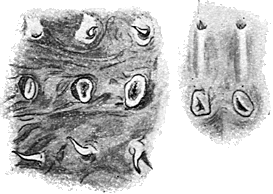Opisthoteuthis pluto
Richard E. Young and Michael VecchioneIntroduction
The largest specimen of Opisthoteuthis pluto described by Berry (1918) was the holotype which reached 540 mm in arm span (arm tip to arm tip).
Characteristics
- Arms
- Arms subequal.
- Female: 5-7 suckers largest; suckers 1-3 very small.
- "Both suckers and cirri apparently more or less completely retractile..."
- Suckers number 80-85 on each arm ("large specimen").
- Male: greatly enlarged suckers in proximal and distal fields; proximal fields apparently equal on all arms; greatly enlarged suckers in distal field present on arms II - IV only (O'Shea, 1999).
Comments
The above description is from Berry (1918) except where otherwise noted. More details of the description of O. pluto can be found here.
O. pluto differs from O. persephone in their pigmentation according to Berry. O. persephone almost invariably has 6 primary gill lamellae (O'Shea, 1999), O. pluto has 8. O. pluto differs from all members of the genus (where males are known), except O. massyae, in having enlarged suckers in the distal field only on arms II-III. It presumably differs from O. massyae in not having especially broad arms I in mature males although this has not been demonstrated.
Distribution
Type locality: 129°28'E, along the Great Australian Bight. Also known from off the coasts of Southwestern Australia (O'Shea, 1999). Vertical distribution is from 275 - 830 m.
References
Berry, S.S. 1918. Report on the Cephalopoda Obtained by the F.I.S. "Endeavour" in the Great Australian Bight and Other Southern Australian Localities. Biological Results of the Fishing Experiments carried on by the F.I.S. "Endeavour", 1909-1914, 4(5):201-298.
O'Shea, Steve. 1999. The Marine Fauna of New Zealand: Octopoda (Mollusca: Cephalopoda). NIWA Biodiversity Memoir 112: 280pp.
About This Page

University of Hawaii, Honolulu, HI, USA

National Museum of Natural History, Washington, D. C. , USA
Page copyright © 2016 and
 Page: Tree of Life
Opisthoteuthis pluto .
Authored by
Richard E. Young and Michael Vecchione.
The TEXT of this page is licensed under the
Creative Commons Attribution-NonCommercial License - Version 3.0. Note that images and other media
featured on this page are each governed by their own license, and they may or may not be available
for reuse. Click on an image or a media link to access the media data window, which provides the
relevant licensing information. For the general terms and conditions of ToL material reuse and
redistribution, please see the Tree of Life Copyright
Policies.
Page: Tree of Life
Opisthoteuthis pluto .
Authored by
Richard E. Young and Michael Vecchione.
The TEXT of this page is licensed under the
Creative Commons Attribution-NonCommercial License - Version 3.0. Note that images and other media
featured on this page are each governed by their own license, and they may or may not be available
for reuse. Click on an image or a media link to access the media data window, which provides the
relevant licensing information. For the general terms and conditions of ToL material reuse and
redistribution, please see the Tree of Life Copyright
Policies.
- First online 13 May 2003
Citing this page:
Young, Richard E. and Michael Vecchione. 2003. Opisthoteuthis pluto . Version 13 May 2003 (under construction). http://tolweb.org/Opisthoteuthis_pluto/20166/2003.05.13 in The Tree of Life Web Project, http://tolweb.org/








 Go to quick links
Go to quick search
Go to navigation for this section of the ToL site
Go to detailed links for the ToL site
Go to quick links
Go to quick search
Go to navigation for this section of the ToL site
Go to detailed links for the ToL site